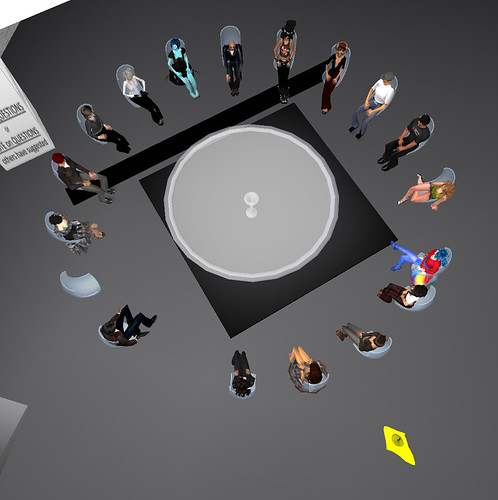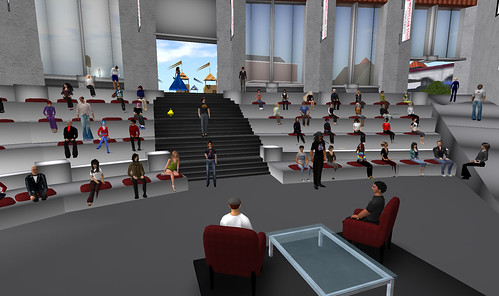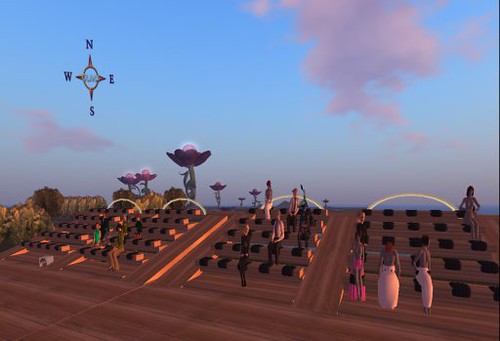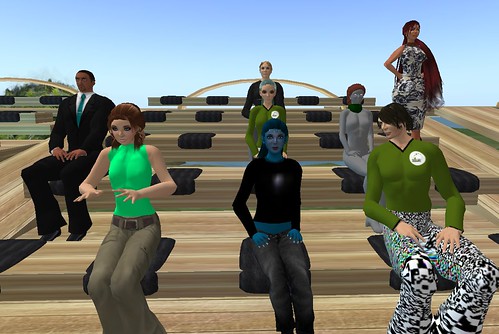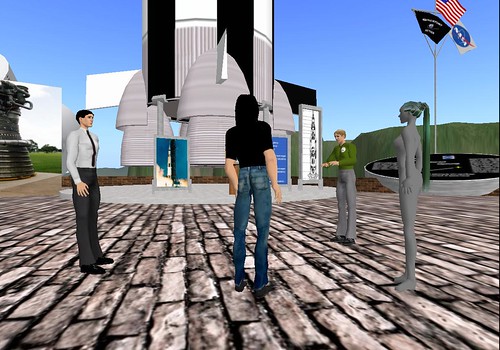
 Location: New Media Consortium Web Site
Location: New Media Consortium Web SiteHamlet Au
recently posted some interesting statistics from Alan Levine and the folks at New Media Consortium.
The findings show a prevalence of educators in Second Life, with only a scattered few in other virtual worlds. The study also reveals how hard it may be to get more faculty to join us.
Why Aren't More of Us In-World? I know that on my campus, I'm one of three faculty who have taught with SL. A fourth made it an optional part of the class. And only one of us is using SL this term (for a single assignment).
I have hundreds of colleagues. Almost all of them use Blackboard. Several dozen use wikis and blogs. Granted, only a handful use GIS data or similar applications. In those cases, however, the application is essential to a colleague's research agenda.
Why no more of us in SL? Let's dig into some of the NMC findings with a graphic that Au did not reproduce. This graph charts answers to the question "What is the number one barrier to broader adoption of virtual worlds by your institution?"

I'm taken by the 91 respondents, 33% of total, who responded that the "learning curve" for virtual worlds is the number one hindrance.
After 3 years in SL, the clunky user interface seems easy enough to me, but I still am a dolt about scripting, the deeper aspects of the "advanced" menu, and more. And, to be honest, I have no intention of learning them. There's not enough reward, professionally, for my taking the time to learn them, and my personal time is too precious to spend on that.
None of the respondents in the NMC survey noted specifically that a lack of incentives and rewards blocks wider implementation, but I suspect that lay behind a number of the "other" (18%) responses. On my campus, I get as much credit, in my annual review, for the 20 hours or so needed to design a new course over the summer or the 30 or so I spent last year on curriculum review as I do for the 400+ hours a year I spend in SL or writing about it. My time included going to meetings like our weekly Roundtable, exploring the metaverse, building an educational simulation, teaching with SL, and blogging about it.
Sure, SL is a lot of fun. But 400 hours? Time is not infinite, and I'm planning to spend less time now in SL and even blogging, after my "personal audit."
How many scholarly articles have I
not written in the past three years because of that missing time? At least two, beyond the one I have written about my work in SL. Even for those of us who do not have tenure, publication is the currency of Academia if one wishes to change jobs.
So please don't be cranky at me if I refuse to join you in the latest social-networking application, virtual world, etc. I'm going to spend my "SL time" reviewing articles for a forthcoming anthology on virtual worlds. My evaluators will understand that and reward me.
Perhaps--I have mislaid the reference to an article on the topic--this is why schools without so much publish-or-perish pressures, even on non-tenured faculty, and with a strong teaching mission have fared better in virtual worlds than have the Ivies.
Schools without such pressure to look good in national ranking have the luxury to try these worlds out. Monetary costs (only cited by 6% of respondents) are, unlike temporal ones, low in virtual worlds.
But, Wait. Other Tools Take Time to Learn, Too!Mastering SL is more akin to designing Web pages than learning to use them well. The only reason SL was fairly simple for me is that I used it to play, too, my first year (and still do, a little). Most of my peers do not, and as
Dan Holt and I have both discovered, a semester of learning would be wise before bringing in a class. I'd claim that several are needed before a faculty member can begin to design anything beyond rudimentary content.
First, other classroom tools with more shallow learning curves, such as wikis, blogs, micro-blogging, photo-sharing, and the like contribute mightily to student multimedia work. And in many cases, support and discussion of them is as close as my office hallway or the library. For many applications, students know already how to use them. When I mentioned that I could join my current course virtually next month during a conference, every student in class had a Skype account and knowledge of the application.
For virtual worlds, I must rely upon my online community for discussion and advice. The folks I collaborate with know a lot, except for one thing: the culture of my school. Moreover, the serendipity of a chat over coffee still works better for me and many of my colleagues.
Second, SL sometimes seems less like a tool to make a project (especially for non-builders!) than a
subject for good work, as in my students race-and-gender-switch assignment in SL or the "Saving Isis" project in Heritage Key.
But I could, in my field, just as readily study race-and-gender biases online with the flat Web. It might not be so intriguing or immersive, but it would far, far easier.
So, Why No Broader Use of Other Virtual Worlds?In Academia we have broadly available ways to connect to our peers in specialized fields: e-lists, academic conferences, journals. All build community, and in the galaxy of virtual worlds, only SL offers that, so far, though Reaction Grid seems to be gaining traction.
Beyond community, there's the utility of features in SL that simply work better than in any competitor's world (and across platforms). For all its warts, SL features working groups, maps, consistent teleports, prim-items that work consistently, and (perhaps most importantly) premade content for sale or even for free.
My ability to quickly purchase a Mystitool table-and-chair system at a Roundtable meeting, using the Xstreetsl portal, let the meeting go on. I suppose in another virtual world I could have made a bunch of plywood cubes to sit on, or our avatars could have just stood up. Either would "break the metaphor" that makes the world immersive and, in various ways, would not have lead to a smooth meeting of 40 people in the same way as a very impressive scripted table and chairs did.
So designers, take heart! Given the lack of time and rewards that educators face, most of us will never become fluent builders and we'll need such good work by others. One can still lead productive classes in SL without making a single cube, but to do that locales for study and inventory become essential. Even freebie items let me class change race and gender well enough to study those aspects of identity.
For now, we educators remain a small part of virtual worlds. Until the software gets more intuitive, we'll remain a small group. And until other virtual worlds offer SL's community, we'll mostly be using the Linden product.
